Parish turned Cathedral Church…
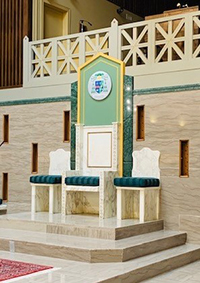 The Cathedral, standing as it is now, did not always look that way. Initially a part of the Diocese of Richmond, Virginia, the Parish of St. Thomas More was founded in 1938, arising out of a need to serve the growing population of Arlington. More specifically, St. Thomas More parish (STM) grew out of St. Charles Borromeo parish (the oldest Catholic parish in Arlington; about a mile and a half north of STM). STM was originally within the geographical area of St. Charles Borromeo parish. To accommodate the growing number of Catholics - STM was established. The first Mass celebrated in the church building was on the First Sunday of Advent, November 27, 1938, by Fr. Edwin Lee, the first pastor of STM - a few days after Thanksgiving. (The people of Arlington had a bit more to be thankful for that year!)
The Cathedral, standing as it is now, did not always look that way. Initially a part of the Diocese of Richmond, Virginia, the Parish of St. Thomas More was founded in 1938, arising out of a need to serve the growing population of Arlington. More specifically, St. Thomas More parish (STM) grew out of St. Charles Borromeo parish (the oldest Catholic parish in Arlington; about a mile and a half north of STM). STM was originally within the geographical area of St. Charles Borromeo parish. To accommodate the growing number of Catholics - STM was established. The first Mass celebrated in the church building was on the First Sunday of Advent, November 27, 1938, by Fr. Edwin Lee, the first pastor of STM - a few days after Thanksgiving. (The people of Arlington had a bit more to be thankful for that year!)
[Another fun fact about Bishop Burbidge - his other favorite movies include: “A Quiet Man”, and “A Man For All Seasons”, which is about St. Thomas More!]
Why the name St. Thomas More?
Newly canonized (at the time) Thomas More was chosen as patron. St. Thomas More was canonized by Pope Pius XI in 1935. This statesman, civil servant, and lawyer would be a fitting patron for a parish - and, as Providence would have it: Diocese - so close to our nation's capital and federal government.
The church building and parish begins to take shape, parish church turns into cathedral…
The original 1938 church became utilized as part of the school building. In 1942, a new church building was completed. This building is now part of the Cathedral school and it has been renamed Lee Hall after the first pastor. In 1949, work began on what is now called “Burke Hall”, which is now the basement of the Cathedral. It was designed to be a transitional church as well as the foundation for a new church. The current church was eventually built at a final cost of $750,000. The church (now Cathedral), as the edifice we know now, was dedicated on December 9, 1961, which interestingly would be the memorial of St. Juan Diego, herald of the message of Our Lady of Guadalupe. This is noteworthy given the importance of Our Lady's patronage of the Americas and the proximity to our nation's capital as well as the Cathedral parish's sizable Hispanic population.
In 1974, when the Diocese of Arlington separated from the Diocese of Richmond, St. Thomas More parish church was named by Pope Paul VI as the Cathedral church for the newly created Diocese. As the largest parish in Virginia at the time, it was the natural choice. Changes were then needed to be made to the sanctuary: the bishop's seat (cathedra) was placed prominently behind the altar. Bishop Welsh would be installed as the first Bishop of the Diocese of Arlington.
The Cathedral underwent renovations in 2015.

Cool fact: Mother Teresa visited the Cathedral in 1982! Check out this Arlington Catholic Herald article on her visit and see some cool pics!
As you tour the Cathedral, bear in mind the rich history of the place and the church that once was beneath your feet (in what is now Burke Hall)!
For more of a detailed synopsis of the history of the Cathedral parish, click the following link to watch this video commemorating the 75th anniversary (1938-2013) of the parish: https://tinyurl.com/cathhistory
Click here for more info on the history of the Diocese of Arlington.
What is the difference between a rector and a pastor?
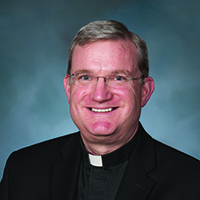
You may have heard the term “rector” for a cathedral. While a pastor is the shepherd of a local parish, the priest overseeing a cathedral is called a “rector”. The rector has the duty of running the liturgical events and overseeing the various administrative tasks of the cathedral. The bishop is the high priest and shepherd of the entire diocese and has as his specially designated church - the cathedral. The bishop does have the primary role of authority over the cathedral which is administered by the rector. The current rector of St. Thomas More Cathedral is Fr. Patrick Posey.
[Another fun fact on Bishop Burbidge: His favorite ice cream flavors are chocolate chip and cherry vanilla!]
Who was St. Thomas More?
“No one has greater love than this, to lay down one's life for one's friends” (John 15:13)
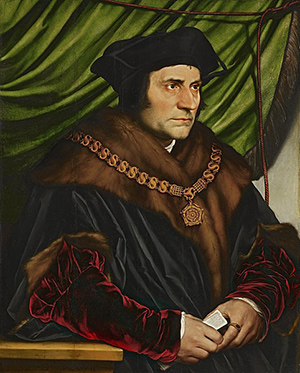 “The king's good servant, but God's first” - known as Thomas More's final words. More put things of Faith and the ways of God ahead of temporal gain and worldly leaders. He was a trusted adviser of King Henry VIII of England, but when Henry asked him to violate his Catholic principles in support of Henry's assertion to be the “Supreme Head” of the Church in England - Thomas refused. This lead to his death, and he is revered as a martyr. (Photo credit: “Sir Thomas More” by Hans Holbein can be found here.)
“The king's good servant, but God's first” - known as Thomas More's final words. More put things of Faith and the ways of God ahead of temporal gain and worldly leaders. He was a trusted adviser of King Henry VIII of England, but when Henry asked him to violate his Catholic principles in support of Henry's assertion to be the “Supreme Head” of the Church in England - Thomas refused. This lead to his death, and he is revered as a martyr. (Photo credit: “Sir Thomas More” by Hans Holbein can be found here.)
Thomas was born in London on February 7, 1478. Thomas learned Latin and Greek at Oxford. He would then go on to become a lawyer. In his mid-twenties, Thomas grew in piety and religious devotion while living near a Carthusian monastery. He would join them frequently for prayers. He ultimately chose to remain in the secular world; he married and was elected to Parliament. But he didn't forget his time with the devoted Carthusian monks, which inspired his deep faith.
Thomas had four children with his first wife, Jane Colt. After Jane's passing, he quickly married Alice Middleton. He gladly received Alice's daughter into his new growing family. Thomas was an affectionate father, regularly writing his children letters while he was traveling for business.
Thomas wrote the book Utopia, about a fictional island community in the Atlantic Ocean, published in 1516.
A faithful civil servant, More gained the respect and admiration of the King Henry. Thomas was known as being intensely loyal to the king. In 1521, he was knighted. Sir Thomas More became Lord Chancellor of England in 1529.
More became at odds with the king, when Henry requested that More support Henry's desire to divorce from his wife, Catherine. More was pressured to support a request for an annulment that was to be sent to Pope Clement VII. More refused to sign and did not attend the coronation of Anne Boylen, Henry's next wife. This angered Henry, who had More arrested and imprisoned in the Tower of London. More would later be beheaded on July 6, 1535. It is said that he quipped with his executioners that they could help him up the scaffold, but that he would see himself down. His final statement has echoed through the centuries: he declared that he was “the king's good servant, but God's first.” His body was buried in the Chapel of St. Peter ad Vincula at the Tower of London, in an unmarked grave.
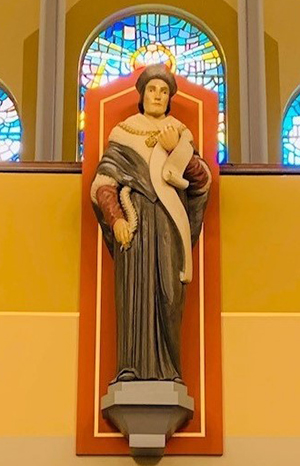 In 1935, Sir Thomas More was canonized by Pope Pius XI, three years before the founding of the parish in Arlington, Virginia, that would take his name as its own - later to become a Diocesan Cathedral.
In 1935, Sir Thomas More was canonized by Pope Pius XI, three years before the founding of the parish in Arlington, Virginia, that would take his name as its own - later to become a Diocesan Cathedral.
In 2000, St. Thomas More was named patron of political leaders by Pope St. John Paul II.
More's feast day is June 22.
Did you know there was a movie made about More's life?! (It's actually a play too!) A Man for All Seasons, depicting the life and struggle of St. Thomas More, was produced in 1966. If you have not seen this movie - a winner of several Academy Awards - why not check it out!? Common Sense Media rates it as being appropriate for children ages 10 and up (find out more here: https://www.commonsensemedia.org/movie-reviews/a-man-for-all-seasons). By the way, as mentioned above, A Man for All Seasons is a personal favorite of Bishop Burbidge!
Some other interesting facts about St. Thomas More - he coined the term utopia, meaning a perfect world or society. He was known for his wit. He is the patron of adopted children. He was the first layperson to hold the position of Lord Chancellor in England. He wore a hair-shirt as an act of penance!
St. Thomas More, pray for us!
Found out more detail on the life of St. Thomas More here: https://www.catholic.org/saints/saint.php?saint_id=324
Check out this short video on St. Thomas More: https://tinyurl.com/videostm
Listen to a podcast on St. Thomas More: https://tinyurl.com/podcaststm
For further reading, check out The King's Good Servant But God's First: The Life and Writings of St. Thomas More by James Monti, published by Ignatius Press.
A Prayer of St. Thomas More:
Lord, grant me a holy heart that sees always what is fine and pure and is not frightened at the sight of sin, but creates order wherever it goes.
Grant me a heart that knows nothing of boredom, weeping and sighing.
Let me not be concerned with the bothersome thing I call “myself”.
Lord, give me a sense of humor and I will find happiness in life and profit for others.
-St. Thomas More
Litany of St. Thomas More
Click here for a litany of St. Thomas More, our patron of the Diocese of Arlington.
Another Patron of our Diocese: St. Elizabeth Ann Seton
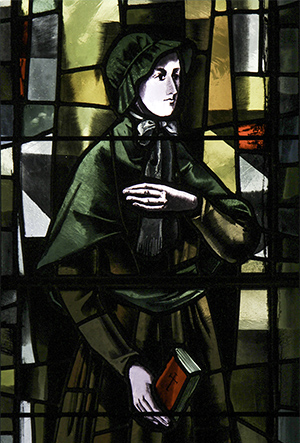 (Photo credit: "St Elizabeth Ann Seton" by Lawrence OP is licensed under CC BY-NC-ND 2.0)
(Photo credit: "St Elizabeth Ann Seton" by Lawrence OP is licensed under CC BY-NC-ND 2.0)
St. Elizabeth Ann Seton was born in NYC in 1774 to an Episcopal family. She married at the age of 19 and had 5 children. Her husband suffered from tuberculosis and was sent to Italy for treatment. Elizabeth and her eldest daughter accompanied him.
While in Italy, Elizabeth and her daughter stayed with her husband's Italian business partners and they introduced Elizabeth and her daughter to Catholicism. After her husband's death they returned to the U.S. and Elizabeth became Catholic in 1805. She started an academy for young ladies but struggled to keep it open.
She met a priest from the French community of the Sulpician Fathers when she was about to move to Canada. In 1809 the Sulpicians invited Elizabeth to move to Emmitsburg where they, along with John Dubois, established Mount St. Mary's University, the first Catholic Seminary for the U.S. With the financial support of a wealthy convert and seminarian, Elizabeth began St. Joseph's Academy and Free School, a school dedicated to the education of Catholic girls.
Later, Elizabeth established a community dedicated to the care of the children of the poor. This was the first congregation of religious sisters to be founded in the U.S. and the school was the first free Catholic school in America. This was the start of the Catholic parochial school system in the U.S. She spent the rest of her life developing the new congregation then known as the Sisters of Charity of St. Joseph.
Elizabeth was known as Mother Seton. Mother Seton died on January 4, 1821 at the age of 46. She was canonized on September 14, 1975 by Pope Paul VI. She is the first native-born U.S. citizen to be canonized a saint. Today, her remains are entombed in the National Shrine of St. Elizabeth Ann Seton in Emmitsburg, MD.
Mother Seton's favorite Psalm was Psalm 23 - The Lord is my Shepherd.
Find out more about Mother Seton here:
Audio book, Elizabeth Seton: American Saint by Catherine O'donnell - check it out here: https://www.audiobooks.com/audiobook/elizabeth-seton-american-saint/342794
The Saintcast Podcast: https://tinyurl.com/elizseton Short Biography - Start at 21:40 - Runs about 13 minutes
There is a stained glass window devoted to Mother Seton in the left transept of the Cathedral.
A Prayer to St. Elizabeth Ann Seton:
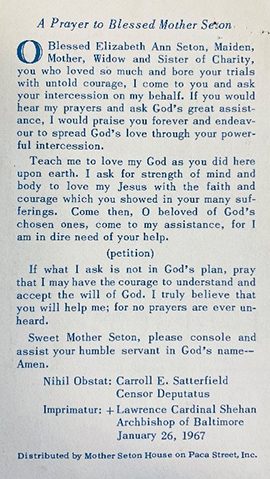
Check out the Encounter on visiting Mother Seton's shrine in Emmitsburg, Maryland.
[Another fun fact on Bishop Burbidge: his favorite saints include St. Michael, St. Francis of Assisi, St. John Neumann, and Pope St. John Paul II. Also, did you know that Bishop Burbidge went to seminary right out of high school? Have you considered a vocation to the priesthood or religious life?]